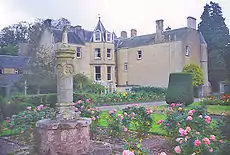John Scrimgeour of Myres
John Scrimgeour of Myres Castle near Falkland, Fife was Master of Work for royal buildings for James V and Mary, Queen of Scots, and Precentor of the Scottish Chapel Royal.

Career
He and his father held their lands by right of an hereditary office as sergeant-of-arms or macer to the King of Scotland.[1] John Scrimgeour kept the building accounts for most of the works of James V from 1529, especially for Falkland Palace and Holyroodhouse and most of these accounts survive. As well as supervising building work and contracts, Scrimgeour also collected taxes, mostly from church lands, which James V had allocated to the works.[2]
From the tax on church lands granted to James V for his expenses in France, from October 1536 to September 1538, Scrimgeour received £4996-7s-10d Scots.[3]
Scrimgeour was briefly eclipsed between 1538 and 1540 when Sir James Hamilton of Finnart was appointed Principal Master of Work with higher authority, and in the first years of the regency of James Hamilton, 2nd Earl of Arran who employed a kinsman, John Hamilton of Milnburn. During the war of the Rough Wooing, in October 1545 Scrimgeour became the treasurer of a force of 1000 border horseman, administering a tax of £18,000 raised for their wages. He was to spend three months in the Merse and Teviotdale attending the musters of this defence force.[4]
A case was brought against Scrimgeour in the Stewartry Court of Fife, held in Falkland Palace on 9 February 1548, when William Bonair of Rossy disputed his rights to the lands of Glasstullo.[5]
In September 1553 he spent £2333-6s-8d on Arran's building works.[6] Subsequently he was employed by Mary of Guise and her daughter, Mary Queen of Scots.[7] He seems to have died in the year 1563, after an exceptionally long innings in post. He was succeeded by sir William MacDowall, who had long been a clerk in the works.[8]
Manuscript
The National Library of Scotland has a volume of heraldic writings which belonged to John Scrimgeour, including a bestiary. The text of the "Deidis of Armorie" also includes advice for heraldic officers, including the Captains of castles and towns, who were instructed to keep certain and sure watch both day and night for fear of the return of plague.[9]
Marriage
Scrimgeour was married to Helen Little. Children included a son, William.[10]
Works
Scrimgeour supervised the construction of timber 'lists', barriers and stand for a tournament at St Andrews in May and June 1538. This was in preparation for the formal reception of Mary of Guise.[11] A series of complete building accounts for the Royal Palaces of James V written by Scrimgeour for audit purposes between 1529 and 1541 survive in the National Archives of Scotland. These were published in full in 1957, and record projects at Holyroodhouse, Stirling Castle, Edinburgh Castle, Falkland Palace, Linlithgow Palace, and other lesser works.[12]
References
- Sheriff Court book of Fife (SHS, 1928): Register of the Great Seal of Scotland, 15 Feb 1530/1.
- Henry Paton, Accounts of the Masters of Work for Building Scottish Castles and Palaces (HMSO: Edinburgh, 1957), pp. xxiii-xxiv, 1−114, 132−292, 297−8.
- James Balfour Paul, Accounts of the Lord High Treasurer of Scotland, vol. 6 (Edinburgh, 1905), pp. 362−363.
- Register of the Privy Council of Scotland, vol. 1 (Edinburgh, 1877), p. 16.
- John Anderson & William Angus, Protocol Book of Sir Alexander Gaw (Edinburgh, 1910), p. 2.
- Accounts of the Lord High Treasurer of Scotland, vol. 10 (Edinburgh, 1913), p. 211.
- Annie Cameron, Scottish Correspondence of Mary of Lorraine (SHS: Edinburgh, 1927), pp. 441-2
- HM Paton (Ediinburgh, 1957), pp. xxvii.
- LAJR Houwen, The Deidis of Armorie, vol. 1 (Scottish Text Society, 1994), pp. lxiii−lxx, 2; vol. 2, p. 90: The line in Scots Language is, "and gar mak certane & sur wachis be him and his folkis, baith be nycht & day, ffor dout of ganfalling in pestlience"
- Register of the Privy Seal of Scotland, vol 5, part 1 (Edinburgh, 1957), 168, no. 756, 18 February 1560.
- Accounts of the Masters of Work, vol. 1 (HMSO: Edinburgh, 1957), pp. 221−222.
- Paton, Henry, ed., Accounts of the Masters of Works, Scotland, vol. 1 (HMSO: Edinburgh, 1957).
| Preceded by James Hamilton of Finnart |
Master of Work to the Crown of Scotland 1529–1563 |
Succeeded by (1) William MacDowall (2) Robert Drummond of Carnock |